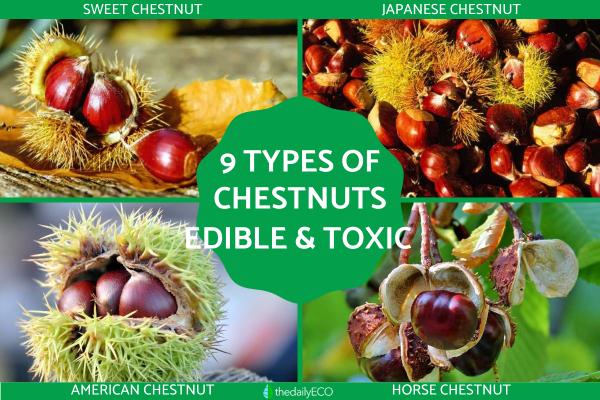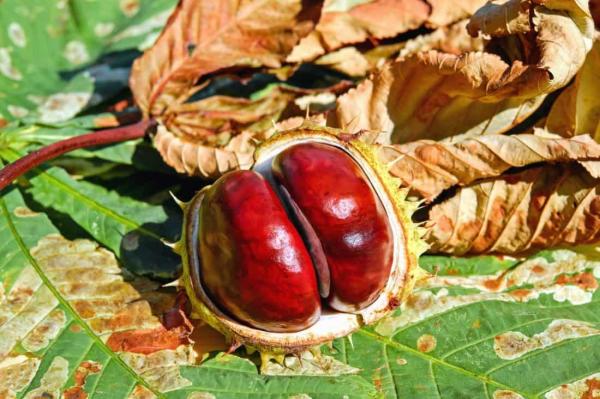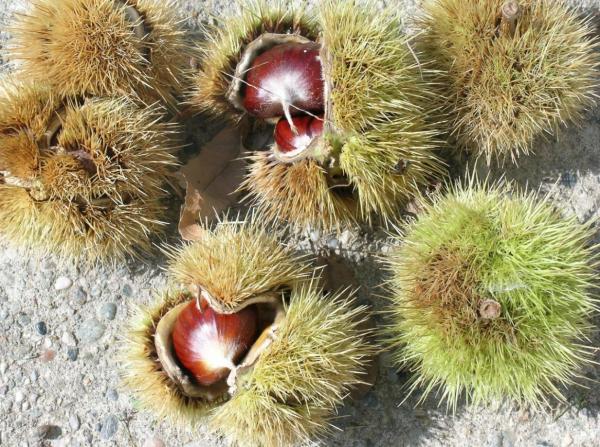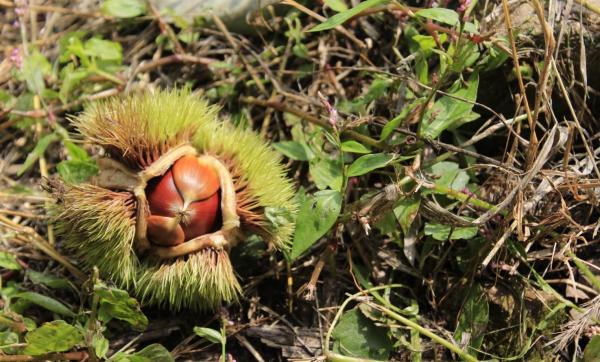Different Types of Chestnuts - Edible and Toxic


The different types of chestnuts fall into three basic categories of American, Asian and European chestnuts. All chestnuts are from the genus Castanea, related to plants such as oak and beech trees as they are in the family Fagaceae. Edible chestnuts are often an abundant nut which is very important to many cultures for food, especially at winter time. These chestnuts have a naturally sweet flavor, but they should be cooked to make the most of them and avoid an upset stomach. We need to specify these are edible chestnuts as not all nuts from species of chestnut tree are edible. In fact, some are toxic.
At thedailyECO, we help you learn more about what chestnuts are safe with our guide to the different types of chestnuts, both the edible and toxic varieties. We explain a little about their characteristics, as well as provide photos of what each chestnut species looks like.
Sweet chestnut (Castanea sativa)
Although the most abundant type of chestnut tree will depend on where you live, the sweet chestnut (Castanea sativa) is the one considered to have the largest distribution. This is because it is the one with the edible nuts most commonly used for food, especially in Europe and Asia. Although it can be found in some parts of Asia, it is the only type of chestnut which is considered a European chestnut. It is also sometimes known as the Spanish chestnut.
The sweet chestnut is a fast-growing tree which can reach heights of up to 100'/30 m. They also stand out for their longevity, with some individual specimens living for over a thousand years. Its leaves are deciduous and lanceolate, with serrated margins, and its dark bark becomes cracked as the tree ages.
Sweet chestnut trees bloom in summer, later giving way to its prized fruits known as chestnuts. They are usually consumed between autumn and early winter. The fruit is covered with long and very spiky thorns which is known as a burr (see photo below). Inside is a layer of fine, velvety tissue that holds the yellow fruit which is edible. Sometimes this film separates the fruit into several compartments, although whole fruits are generally more appreciated.
There are also multiple varieties of Spanish or common chestnut. The following are some of the best known types:
- Marigoule: a hybrid variety between Castanea crenata and Castanea sativa. The fruit is medium to large in size and ripens between September and October.
- Olargues: a variety that ripens in mid-October, with chestnuts of medium size. Originally from France.
- Belle Epine: a chestnut that stands out for the large size of its fruit which ripens at the end of October.
- Comballe: another French variety that ripens later in early November, somewhat larger than the Belle Epine.
- Bournette: another hybrid variety also the fruit of Castanea Sativa and Castanea Crenata. Ripens from the end of December and bears medium-to-large fruits.
Learn about another type of true nut with our article on how to grow a tree from a walnut.

Chinese chestnut (Castanea mollissima)
As its name suggests, the Chinese chestnuts comes from China and is a type of Asian chestnut. In its native soil, it grows above 2,500 meters of altitude. It is smaller than the European chestnut, growing to heights of 40'/12 m. They have a rounded, umbrella-like crown and low branches. The smell of its flowers is very intense when the tree produces them in spring. It is easily cultivated thanks to its high resistance to both drought and pollution.

Japanese chestnut (Castanea crenata)
Another type of edible Asian chestnut, the Japanese chestnut (sometimes known as the genus Castanea japonica) can be found in Japan, but also in China and in Korea. It is native to mountainous areas below 3,000 meters of altitude. It can grow a little more than the Chinese, although it is usual to find it in the form of a simple bush. Its small chestnuts are edible, usually boiled or roasted. As you can see in the photo, they also have burrs.

American chestnut (Castanea dentata)
The American chestnut is a species that used to be very numerous, but which has been seriously affected by a disease from the beginning of the 20th century that is still active today. It was a very important species to indigenous Americans, who extracted its wood and ate its fruits. Its natural range is on the East of the USA. It is also edible and noted for its sweet taste.

Horse chestnut (Aesculus hippocastanum)
This is not a true chestnut as it is not part of the Castanea genus, but it is important to add to our list of the different types of chestnut. The Asculus hippocastanum chestnut is toxic due to its content of a toxic compound known as esculin and should never be eaten. Due to its toxic nature, the ingestion of horse chestnut can result in
These types of trees are large and belong to the order Sapindales, being very commonly used in parks and green areas due to their great aesthetic appeal and their ability to provide shade. Its leaves are distinguished by being large and compound, with 5 or 7 leaflets with slightly jagged edges. As you can see the in the photo below, the fruit is much less spiky and much greener than true chestnuts. The chestnut itself is more rounded than the edible types of chestnut and does not end in a point.

Other types of chestnuts
The remaining different types of chestnuts are not toxic since they are part of the genus Castanea. All chestnuts in this genus are edible:
- Seguin chestnut (Castanea seguinii)
- Ozark chinkapin (Castanea ozarkensis)
- Dwarf chestnut (Castanea pumila)
- Henry's chestnut (Castanea henryi)
Learn about where chestnut trees are grown with our guide to the different types of forests.
If you want to read similar articles to Different Types of Chestnuts - Edible and Toxic, we recommend you visit our Outdoor plants category.










